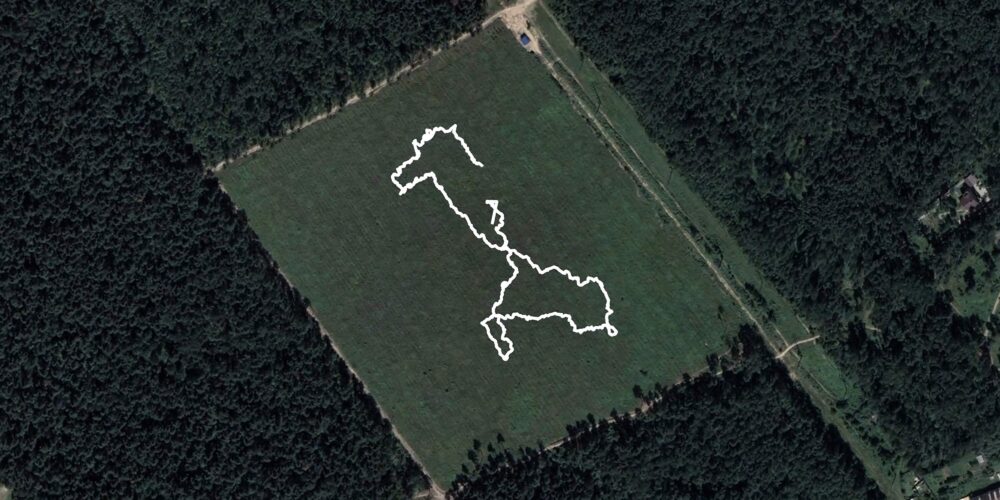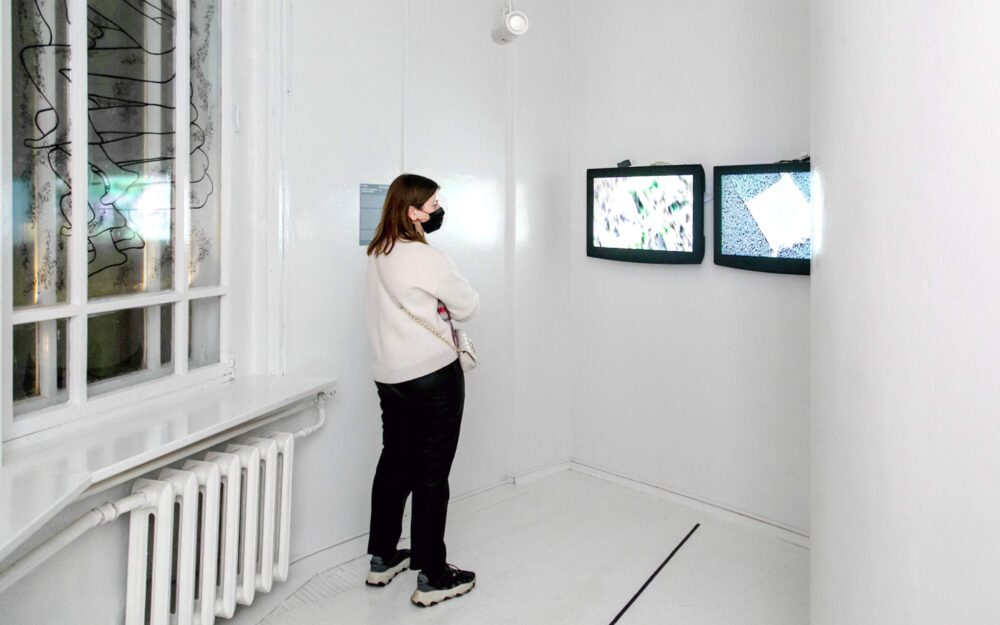The two-channel video is the result of a bodily experiment in which the artist placed herself in the center of the field and allowed her body to crawl in any direction until exhausted. This method of movement was called “automatic crawling”, by analogy with “automatic drawing”, since in the course of the experiment the whole body became an instrument that manifested its spontaneity, performative automatism. While crawling, the artist was recording on the camera the surface of the crawled section of the path, while simultaneously tracking her movement using GPS.
The artifact obtained at the end of the experiment was a chaotic, semi-abstract close-up video from the surface of the ground and an abstract linear image in the field surface from the satellite map. The drawing obtained as a result of “automatic crawling” inside the satellite map — an abstract scrawl — revealed in itself an ancient form of landscape drawing — a geoglyph.
The geoglyph, as a giant landscape drawing inaccessible to the human eye, was part of the rituals intended for the gods. A geoglyph could only be seen and understood by a deity. From a philosophical perspective, the phenomenon of the geoglyph problematizes the epistemological role of the possibility of seeing, which is expressed in its most radical form in Berkeley’s idea that in fact only what is seen does exist.[1] What no one sees exists only due to the all-encompassing sight of God.[2]
The drawing, or glyph, created by the artist, is only virtually drawn on the ground. It has no visible trace and there is no spectator who could see the movement that created the drawing. The role of the ancient god perceiving the geoglyph is played by the GPS satellite system. The glyph, as the god constructed in the project sees it, is only a drawing on a Google map: this point of view is not available to any human begin. Thus, the project creates an epistemological situation in which the questions “What did the artist create with her crawling?”, “Where does the drawing-glyph exist?” and “What is the ontological status of this drawing?” don’t have a simple answer.
The project constructs a philosopheme through the score of the performative part. Therefore, it is important that the movement is automatic, and the drawing on the ground is not meaningful, in contrast to how the ancients did it. When creating a meaningful drawing, the artist would become the very Berkeleian spirit that knows this drawing. Automatic crawling, which obfuscates landmarks and does not give a vision of the whole field, leaves a random drawing lost even for the crawler herself. The spirit of the artist does not know and cannot reconstruct the drawing, it sees just a rough and raw encounter with the ground, a point of view comparable to that of a wandering animal or a crawling caterpillar. This is how the Berkeleian philosopheme arises, and a one-of-a-kind geoglyph — a glyph.
References
| ↑1. | Berkeley, G. 1901. “A Treatise Concerning the Principles of Human Knowledge”. In vol. 1 of The Works of George Berkeley. 4 vols. Oxford: Clarendon Press. §3, P. 259: “For as to what is said of the absolute existence of unthinking things, without any relation to their being perceived, that is to me perfectly unintelligible. Their esse is percipi; nor is it possible they should have any existence out of the minds or thinking things which perceive them”; §6, P 260–261: “all those bodies which compose the mighty frame of the world, have not any subsistence without a mind; that their being is to be perceived or known; […] consequently so long as they are not actually perceived by me, or do not exist in my mind, or that of any other created spirit, they must either have no existence at all, or else subsist in the mind of some Eternal Spirit.” |
|---|---|
| ↑2. | Berkeley, G. 1901. “Three Dialogues Between Hylas And Philonous…”. In vol. 1 of The Works of George Berkeley. 4 vols. Oxford: Clarendon Press. P. 424: “Phil[onous]. […] To me it is evident, for the reasons you allow ofpe, that sensible things cannot exist otherwise than in a mind or spirit. Whence I conclude, not that they have no real existence, but that, seeing they depend not on my thought, and have an existence distinct from being perceived by me, there must be some other Mind wherein they exist. As sure, therefore, as the sensible world really exists, so sure is there an infinite omnipresent Spirit who contains and supports it.” |

